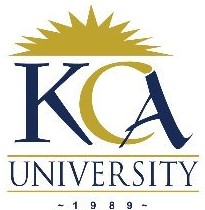 UNIVERSITY EXAMINATIONS: 2010/2011
UNIVERSITY EXAMINATIONS: 2010/2011
THIRD YEAR STAGE EXAMINATION FOR THE DEGREE OF BACHELOR
OF SCIENCE IN INFORMATION TECHNOLOGY
BIT 3105: NETWORK PROGRAMMING
DATE: JUNE 2011 TIME: 2 HOURS
INSTRUCTIONS: Answer question ONE and any other TWO questions
Question One
a)Define the following Network Programming terms: [5 Marks]
i. Concurrent server
ii. TCP Segments
iii. Carrier Sense Multiple Access with Collision Detection (CSMA/CD)
iv. Application Program Interface (API)
v. Distributed System
b)Many business applications being written today use the client–server model including the
Internet’s main application protocols, such as HTTP, SMTP, Telnet, and DNS. List and Explain
Four (4) Classes of Client/Server Applications [4 Marks]
c)Classify the protocols IP, TCP, and FTP, and HTTP according to the ISO OSI hierarchy.
[5 Marks]
d)Suppose a student connects from his PC to the web server of KCA University to retrieve the
university home page. Explain how the three protocols IP, TCP, and HTTP interact so that the
student can view that page. [7 Marks]
e)Explain the use of the following Network Programming Commands and illustrate how they are
used in C++. [6 Marks]
i.Bind()
ii. Socket()
iii.Listen()
f) List and explain three (3) common Middleware systems services [3 Marks]
Question Two
a)Compare and contrast the one-tier, two-tier, three-tier, and n-tier models for distributed systems.
[5 Marks]
b)List and explain five (5) types of transparencies implemented in distributed systems. [5 Marks]
c)How transparency is achieved in distributed systems. [5 Marks]
d)Show, with the aid of diagrams, how the three-tier model could be applied to the design of a
distributed system. [5 Marks]
Question Three
a)What are stubs in an RPC implementation? [5 Marks]
b)What are the three steps a programmer follows when writing a RPC-based code. [3 Marks]
c)Explain any five (5) error conditions we need to guard against in a distributed environment that
we do not need to worry about in a local programming environment? [5 Marks]
d)What is the advantage of having an Iterative server while implementing a RPC [5 Marks]
Question Four
a)What is a socket? [3 Marks]
b)List and Explain the two important TCP Socket classes [4 Marks]
c)Distinguish between TCP sockets and UDP sockets.[4 Marks]
d)Explain the various socket functions required to implement a simple ‘client’ module. What
steps are followed when Programming a TCP client application. [9 Marks]
Question Five
a)What are the Key Components Implementing Remote procedure call (on the client side and on
the server side) [8 Marks]
b)What is an Interface Definition Language (IDL) [6 Marks]
c)Why is IDL necessary when building distributed systems? [6 Marks]
